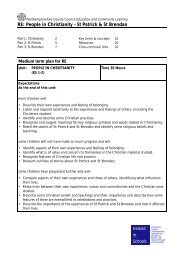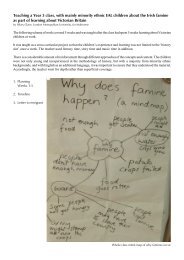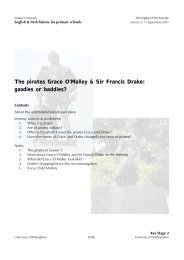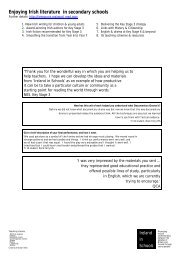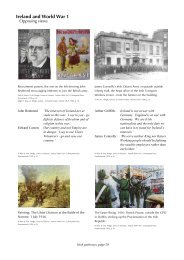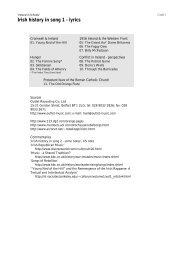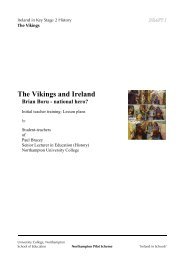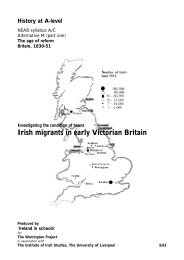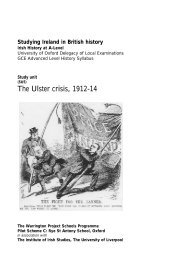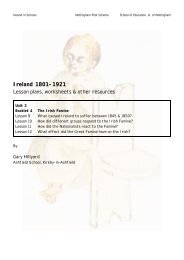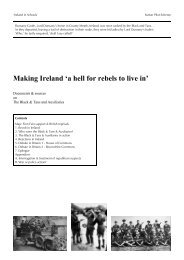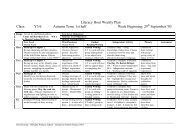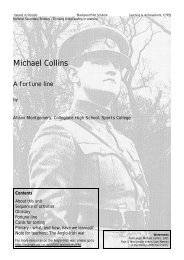New Key Stage 3 History Programme of Study A ... - Ireland in Schools
New Key Stage 3 History Programme of Study A ... - Ireland in Schools
New Key Stage 3 History Programme of Study A ... - Ireland in Schools
You also want an ePaper? Increase the reach of your titles
YUMPU automatically turns print PDFs into web optimized ePapers that Google loves.
S<strong>in</strong>gle lesson1.3. Orig<strong>in</strong> <strong>of</strong> English stereotypes about <strong>Ireland</strong> & the Irish. Assess<strong>in</strong>g the value <strong>of</strong>Gerald <strong>of</strong> Wales as evidencehttp://iisresource.org/stereotypes_norman.aspxDepth study1.6. The Normans & <strong>Ireland</strong>. Norman greed, Irish weakness or someth<strong>in</strong>g else?http://members.aol.com/iis04/Normans_Bham_Y7.pdfNorthern <strong>Ireland</strong>Resource8.19. Cont<strong>in</strong>ued sectarianism among young people?http://iisresource.org/Documents/Reconciliation%20or%20Stereotyp<strong>in</strong>g.htmlIndividual or state action?Fam<strong>in</strong>eS<strong>in</strong>gle lesson4.1. Why did Baby Bridget die 1?http://hometown.aol.co.uk/Iis04/Why_Did_BB_Die.pdfDepth study4.6. Why is the Fam<strong>in</strong>e important <strong>in</strong> British & Irish history?http://hometown.aol.co.uk/KHA200/Fam<strong>in</strong>e_Important_2_Wkbk.pdfResource4.14. Pictures <strong>of</strong> children <strong>in</strong> the Irish Fam<strong>in</strong>ehttp://members.aol.com/iis05/Children_<strong>in</strong>_Irish_Fam<strong>in</strong>e.pdfInterpretation4.28. Interpretations <strong>of</strong> the Fam<strong>in</strong>ehttp://iisresource.org/Documents/KS3_Fam<strong>in</strong>e_Interpretations.pdfICT - web quests 4.9. The truth about c<strong>of</strong>f<strong>in</strong> ships?http://iisresource.org/c<strong>of</strong>f<strong>in</strong>_ships.aspx4.27. The Irish Potato Fam<strong>in</strong>e: a web questhttp://www.ehhs.cmich.edu/~new192/webquest.htmlIiS, Irish <strong>History</strong> for <strong>Key</strong> <strong>Stage</strong> 3, 4
0. GeneralB. <strong>Study</strong> units0.1. Irish pathway thoughKS3 history 1Romans to Ris<strong>in</strong>gTrafford Irish pathway0.2. Irish pathway thoughKS3 history 2Normans to WW1 & beyondTuxford Irish pathway0.3. Th<strong>in</strong>k<strong>in</strong>g Skills -Normans, Plantation <strong>of</strong>Ulster, Northern <strong>Ireland</strong>Nott<strong>in</strong>gham Pilot Scheme0.4. Irish history & theSecondary National StrategyBlackpool Pilot Scheme0.5. What do songs revealabout our study <strong>of</strong> Irishhistory?Blackpool Pilot Scheme -Th<strong>in</strong>k<strong>in</strong>g skills exerciseWhen Urmston Grammar School re-organised its <strong>History</strong> curriculum at <strong>Key</strong> <strong>Stage</strong> 3around a series <strong>of</strong> key questions, it <strong>in</strong>corporated, where appropriate, Irish material tohelp answer these questions, thus form<strong>in</strong>g an Irish pathway throughout KS 3 <strong>History</strong>.This was part <strong>of</strong> a general policy to promote knowledge and understand<strong>in</strong>g <strong>of</strong> <strong>Ireland</strong> <strong>in</strong>the school and also an attempt to provide a sound basis for the more specialised study <strong>of</strong>conflict <strong>in</strong> <strong>Ireland</strong> as part <strong>of</strong> the GCSE <strong>History</strong> <strong>in</strong> Years 10-11.http://iisresource.org/Documents/KS301_Irish_Pathway_Trafford.pdfhttp://hometown.aol.co.uk/Iis05/Normans_<strong>Ireland</strong>_Trafford_Opt.pdfStudents at Tuxford School enjoy the Irish coursework element <strong>of</strong> their SHP GCSE<strong>History</strong> course, but used to compla<strong>in</strong> about how much was required <strong>of</strong> them. The issueswere complex and the historical coverage almost overwhelm<strong>in</strong>g. They also asked that if<strong>Ireland</strong> is so important, why does it appear only at GCSE.In response to these comments, Tuxford School <strong>in</strong>troduced elements <strong>of</strong> the history <strong>of</strong><strong>Ireland</strong> and Anglo-Irish relations <strong>in</strong>to the <strong>History</strong> curriculum at <strong>Key</strong> <strong>Stage</strong> 3. Thesyllabus is based on a series <strong>of</strong> ‘focus questions’ for each term. The focus questions are<strong>in</strong> turn addressed through a series <strong>of</strong> ‘organis<strong>in</strong>g questions’.http://iisresource.org/Documents/KS302_Irish_Pathway_Tuxford.pdfhttp://members.aol.com/iis03/Normans_Notts_Y7.pdf1. Why did the Normans go to <strong>Ireland</strong>?2. Pictures from Memory: Omagh <strong>in</strong> 16103. Concept map: why has there been tension <strong>in</strong> <strong>Ireland</strong>?4. Storytell<strong>in</strong>g task: Bloody Sunday5. Odd One Out: Personalities & organisations <strong>in</strong> Northern <strong>Ireland</strong>http://hometown.aol.co.uk/Iis04/Secondary_Hist_Th<strong>in</strong>k<strong>in</strong>g_Skills.pdfOverview1. Us<strong>in</strong>g an advance organiser: The Normans & <strong>Ireland</strong>2. Fortune l<strong>in</strong>e:Compar<strong>in</strong>g the lives <strong>of</strong> Grace O’Malley & Elizabeth IMichael Coll<strong>in</strong>s3 & 4. Collective memory & Audience & purpose: Cromwell <strong>in</strong> <strong>Ireland</strong>5. A mystery: Reasons for an Irish disapora6. Relational diagram: Fight<strong>in</strong>g for whom? - 19167. Read<strong>in</strong>g images & Collective memory: Murals <strong>in</strong> Northern <strong>Ireland</strong>8. Exam<strong>in</strong><strong>in</strong>g audience & purpose: What do songs reveal about our study <strong>of</strong> Irishhistory?9. Classify<strong>in</strong>g & summaris<strong>in</strong>g: Why are Protestants & Catholics will<strong>in</strong>g to sharepower <strong>in</strong> Northern <strong>Ireland</strong> now & not earlier?10. Plenaries: Metacognitive reflection exerciseshttp://iisresource.org/KS3_Strategy_<strong>History</strong>.aspxExam<strong>in</strong><strong>in</strong>g audience & purpose1. Listen to the song. Look at the lyrics whilst you listen.2. Complete the Graphic Organisers for each song.In the central box (number 1) write down what you th<strong>in</strong>k is the STORY the sotell<strong>in</strong>g.3. In box number 2 write down what you th<strong>in</strong>k the MESSAGE <strong>of</strong> the song is.What is the s<strong>in</strong>ger try<strong>in</strong>g to say? How does he/she get the message across?What is the MOOD <strong>of</strong> the song?4. How does the song HELP you understand Irish history?How does the song help you understand people’s attitudes?Write down your thoughts <strong>in</strong> box number 3.5. In box number 4 write down what PROBLEMS exist with this song.Is it reliable?Does it tell you everyth<strong>in</strong>g you need to know about Irish history and attitudes?What other <strong>in</strong>formation do you th<strong>in</strong>k you will need to f<strong>in</strong>d out more?http://iisresource.org/Documents/Blackpool_Songs_KS3.pdfIiS, Irish <strong>History</strong> for <strong>Key</strong> <strong>Stage</strong> 3, 5
C. Other resources0.6. Mythical <strong>Ireland</strong> A rich resource for ancient sites and myths and legends.http://www.mythicalireland.com0.7. Introduction to Irish<strong>History</strong> PowerPo<strong>in</strong>t0.8. <strong>Ireland</strong>’s <strong>History</strong> <strong>in</strong>MapsAn overview from prehistoric <strong>Ireland</strong> to the 1916 ris<strong>in</strong>g.http://www.facstaff.bucknell.edu/rickard/irishhistory.pptMap from the Ice ages to the Fam<strong>in</strong>e.http://www.rootsweb.com/~irlkik/ihm/iremaps.htmIiS, Irish <strong>History</strong> for <strong>Key</strong> <strong>Stage</strong> 3, 6
1.6. The Normans & <strong>Ireland</strong>Norman greed, Irishweakness or someth<strong>in</strong>g else?Birm<strong>in</strong>gham Pilot Scheme1.7. The Normans & <strong>Ireland</strong>Blackpool Pilot Scheme -Th<strong>in</strong>k<strong>in</strong>g skills exercise1. What does the story Aoife, Strongbow’s wife, tell us about the Normans & <strong>Ireland</strong>??2. What does a modern historical novel about Strongbow & Aoife tell us?3. What was <strong>Ireland</strong> like before the Normans went there?4. Why did the Normans go to <strong>Ireland</strong>?1. What happened? 2. What does this tell us about the Normans and the Irish?5. What changes can we f<strong>in</strong>d by look<strong>in</strong>g at a map <strong>of</strong> <strong>Ireland</strong>?6. Was this really different from what was happen<strong>in</strong>g <strong>in</strong> Brita<strong>in</strong>?http://members.aol.com/iis04/Normans_Bham_Y7.pdfUs<strong>in</strong>g an advance organiser ... as a structural tool for a research project1. About <strong>Ireland</strong>: Basic facts & map2. Gaelic <strong>Ireland</strong>: What was <strong>Ireland</strong> like before the Norman went there?3. Chang<strong>in</strong>g <strong>Ireland</strong>: What changes can we f<strong>in</strong>d by look<strong>in</strong>g at a map <strong>of</strong> <strong>Ireland</strong>?4. What impact did the Normans have on <strong>Ireland</strong>?5. Plenary: What & how have we learned - th<strong>in</strong>k<strong>in</strong>g wordshttp://hometown.aol.co.uk/Iis05/01_Organiser_Normans_A4_Sheets.pdfC. Other resources1.8. Beg<strong>in</strong>n<strong>in</strong>g <strong>of</strong> Englishstereotypes about <strong>Ireland</strong> &the Irish1.9. An Irish view <strong>of</strong> theNorman <strong>in</strong>tervention <strong>in</strong><strong>Ireland</strong> PowerPo<strong>in</strong>t1.10. A Norman conquest <strong>of</strong><strong>Ireland</strong>? Some sources1.11. Irish submission toHenry II: nationalhumiliation orcommonsense?Gerald <strong>of</strong> Wales: Norman views on <strong>Ireland</strong> and the Irishhttp://hometown.aol.co.uk/Iis03/Norman_Images_<strong>Ireland</strong>.pdfFor jpg files:http://ireland<strong>in</strong>schools.myphotoalbum.com/view_album.php?set_albumName=album06‘The Marriage <strong>of</strong> Strongbow and Aoife’ by Daniel MacLise, 1854.MacLise was sympathetic to the Young <strong>Ireland</strong>ers who sought freedom from Brita<strong>in</strong> <strong>in</strong>the mid-19th century.The recurrent theme <strong>of</strong> the pa<strong>in</strong>t<strong>in</strong>g is that the Anglo-Irish relationship is a forcedmarriage.http://iisresource.org/Documents/Marriage_S_A .pptPa<strong>in</strong>t<strong>in</strong>g: ‘The Marriage <strong>of</strong> Strongbow and Aoife’ by Daniel MacLise, 1854Maps: Irish k<strong>in</strong>gdoms and sub-k<strong>in</strong>gdom, 1150, Land hold<strong>in</strong>gs <strong>in</strong> <strong>Ireland</strong>, 1450Laws: Statute <strong>of</strong> Kilkenny, 1366Contemporary account: Gerald <strong>of</strong> Wales, The <strong>History</strong> and Topography <strong>of</strong> <strong>Ireland</strong>Historical novel: Strongbow. The Story <strong>of</strong> Richard and Aoife by Llywelyn, Morgan,O’Brien Press, 0-86278-274-0http://iisresource.org/Documents/Norman_<strong>Ireland</strong>_Sources.pdfHistorians’<strong>in</strong>terpretations <strong>of</strong> the Norman <strong>in</strong>tervention <strong>in</strong> <strong>Ireland</strong>.http://iisresource.org/Documents/KS3_Normans_Interpretation.pdfIiS, Irish <strong>History</strong> for <strong>Key</strong> <strong>Stage</strong> 3, 8
2. <strong>Ireland</strong> & the TudorsA. S<strong>in</strong>gle lessons2.1. Propaganda <strong>in</strong> the 16thcenturyHA workshop2.2. Why were so many ships<strong>of</strong> the Spanish Armadawrecked <strong>of</strong>f the west coast <strong>of</strong><strong>Ireland</strong>?Wirral workshopB. <strong>Study</strong> units2.3. Tudor <strong>Ireland</strong>A fortune l<strong>in</strong>e compar<strong>in</strong>gthe lives <strong>of</strong>Elizabeth I & Grace O’MalleyBlackpool Pilot Scheme -Th<strong>in</strong>k<strong>in</strong>g skills exercise)2.4. Who should control<strong>Ireland</strong>: Tudor monarchs orIrish lords?Birm<strong>in</strong>gham Pilot SchemeVisual sources: (A) Catholic propaganda pr<strong>in</strong>t, show<strong>in</strong>g martial law used aga<strong>in</strong>st IrishCatholic dissidents as well as political enemies. (B) Tudor representation <strong>of</strong> the outdoord<strong>in</strong><strong>in</strong>g habits <strong>of</strong> an Irish k<strong>in</strong>g.1. Sit <strong>in</strong> pairs, back to back, and one describes to the other the visual sources A or B.Or Work<strong>in</strong>g <strong>in</strong> pairs, give labels to the visual sources, A and B.2. Look aga<strong>in</strong> at source B - the Irish k<strong>in</strong>g d<strong>in</strong><strong>in</strong>g outdoors. A woodcut, it is one <strong>of</strong> thefew visual sources we have <strong>of</strong> <strong>Ireland</strong> <strong>in</strong> the 16th century.a. What can you learn from the picture?b. Does it give you any clue about the engraver’s op<strong>in</strong>ion <strong>of</strong> the Irish?http://iisresource.org/propaganda_sixteenth_century.aspx1. On map A, plot the Irish Armada wrecks, us<strong>in</strong>g, where possible, source D, list<strong>in</strong>g theship name and date aga<strong>in</strong>st the wreck site.Discussiona. Reasons for the numerous wrecks - weather, etc.b. Pattern <strong>of</strong> wrecks, geographical features, etc.2. Us<strong>in</strong>g the lyrics and music <strong>of</strong> ‘The Spanish Armada’ (source E), explore why therewere so many Spanish ships wrecked <strong>of</strong>f the west coast <strong>of</strong> <strong>Ireland</strong>.http://hometown.aol.co.uk/KHA200/Wirral_Armada_Exercise.pdf1. Sequence <strong>of</strong> activities2. Fortune l<strong>in</strong>e3. Cards for sort<strong>in</strong>g & plac<strong>in</strong>g on fortune l<strong>in</strong>e4. Plenary: What & how have we learned - th<strong>in</strong>k<strong>in</strong>g wordshttp://hometown.aol.co.uk/KHA200/Irish_Fortune_L<strong>in</strong>e.pdf1. What happened at Mullaghmast <strong>in</strong> 1578? Scenario: Baby whiteboard with writtensources <strong>in</strong> centre with visuals on lam<strong>in</strong>ated card.a. Underl<strong>in</strong>e <strong>in</strong> colour A any <strong>in</strong>formation <strong>in</strong> each <strong>of</strong> the blue sources that helps youunderstand what happened.b. Underl<strong>in</strong>e <strong>in</strong> colour B any words which suggest that these events were shock<strong>in</strong>g.c In what way, if at all, do these sources help to expla<strong>in</strong> the woodcuts.d. Write a short report, 20-30 words, <strong>of</strong> what happened.e. In pairs, look at both accounts aga<strong>in</strong> and decide on the similarities and differencesbetween them.f. What more would you like to know about this massacre? Formulate somequestions, to which you would like answers.2/3. Why did the massacre <strong>of</strong> Mullaghmast take place?4. Was their Irish policy worthwhile for the Tudors?Scenario: Two talk<strong>in</strong>g heads with speech bubbles. A hard l<strong>in</strong>e Tudor <strong>of</strong>ficial and as<strong>of</strong>ter l<strong>in</strong>e Tudor <strong>of</strong>ficial.a. As a class, us<strong>in</strong>g work from the previous lesson, establish some criteria by whichto judge whether their Irish policy was worthwhile for the Tudors.b. Divide class <strong>in</strong>to six groups, three for each head. Each group a. looks at sourcesbelow <strong>in</strong> order to support their case and to rebut arguments aga<strong>in</strong>st; b. selects fourto six sources that are most useful <strong>in</strong> support<strong>in</strong>g each <strong>of</strong> the two views; and c. fills<strong>in</strong> four to six speech bubbles.Note for teachers:http://hometown.aol.co.uk/Iis04/Tudor_Conquest_Teacher_Note_03.pdfWorksheets for students:http://members.aol.com/iis04/Tudor_Conquest_Worksheets_Internet_03.pdfNarrative for students:http://hometown.aol.co.uk/Iis04/Tudor_conquest_02.pdfIiS, Irish <strong>History</strong> for <strong>Key</strong> <strong>Stage</strong> 3, 9
2.5. The Tudors & <strong>Ireland</strong>Trafford Pilot Scheme1. Henry VIII and <strong>Ireland</strong>. A new policy?2. How successful was the Protestant Reformation <strong>in</strong> <strong>Ireland</strong>?3. How did Elizabeth respond to the threat from <strong>Ireland</strong>?http://hometown.aol.co.uk/Iis03/Trafford_KS3_Y8.pdfC. Other resources2.6. Who should control<strong>Ireland</strong>?An account for students <strong>of</strong> the Tudor attempt to control <strong>Ireland</strong> <strong>in</strong> the 16 th century:http://hometown.aol.co.uk/Iis04/Tudor_conquest_02.pdf2.7. Tudor images <strong>of</strong> <strong>Ireland</strong> John Derrick, Image <strong>of</strong> <strong>Ireland</strong>, 1581, with its tell<strong>in</strong>g woodcuts, one <strong>of</strong> the most<strong>in</strong>fluential publications which presented the Irish <strong>in</strong> a bad light, partly to expla<strong>in</strong> andjustify the forward policy <strong>in</strong> <strong>Ireland</strong>.http://hometown.aol.co.uk/Iis03/Tudor_Images_<strong>Ireland</strong>.pdfFor jpg files:http://ireland<strong>in</strong>schools.myphotoalbum.com/view_album.php?set_albumName=album012.8. The eclipse <strong>of</strong> Gaelic<strong>Ireland</strong> <strong>in</strong> Bardic poetry2.9. Why was Steven Ellis’s<strong>Ireland</strong> <strong>in</strong> the age <strong>of</strong> theTudors attacked by otherhistorians <strong>of</strong> <strong>Ireland</strong>?Poems reflect<strong>in</strong>g the English conquest <strong>of</strong> <strong>Ireland</strong> and the death <strong>of</strong> Gaelic society throughconfidence, forebod<strong>in</strong>g and eclipse.http://hometown.aol.co.uk/Iis03/Eclipse_Gaelic_<strong>Ireland</strong>_Poetry.pdfHistorians’ disagreements about <strong>Ireland</strong> <strong>in</strong> the sixteenth century and the Tudor conquest.http://iisresource.org/documents/KS3_Tudor_<strong>Ireland</strong>_Interpretation.pdfIiS, Irish <strong>History</strong> for <strong>Key</strong> <strong>Stage</strong> 3, 10
3. <strong>Ireland</strong> & the Stuarts & CromwellA. S<strong>in</strong>gle lessons3.1. What changes did thePlantation <strong>of</strong> Ulster br<strong>in</strong>g?Nott<strong>in</strong>gham Pilot Scheme -th<strong>in</strong>k<strong>in</strong>g skills exercise3.2. Why did the Englishwant to control <strong>Ireland</strong>?Nott<strong>in</strong>gham Pilot SchemeB. <strong>Study</strong> units3.3. Reputations. Sources:Cromwell at DroghedaSomerset Pilot Scheme3.4. Cromwell <strong>in</strong> <strong>Ireland</strong>Collective memory& Audience & PurposeBlackpool Pilot Scheme -Th<strong>in</strong>k<strong>in</strong>g skills exercise3.5. Battl<strong>in</strong>g for <strong>Ireland</strong> <strong>in</strong>the 17th century: Droghedaand the BoyneNorthampton Pilot SchemePupils work<strong>in</strong>g <strong>in</strong>dividually.1. Read the extract from Lord Carew, describ<strong>in</strong>g Omagh <strong>in</strong> 1610.2. Pupils draw the map/picture <strong>of</strong> Omagh by listen<strong>in</strong>g to the description3. Suggest re-read as <strong>in</strong> a language listen<strong>in</strong>g exercise.5. Pupils work out strategy themselves-notes, bullet po<strong>in</strong>ts, rough sketches, etc.http://hometown.aol.co.uk/Iis04/Secondary_Hist_Th<strong>in</strong>k<strong>in</strong>g_Skills.pdf1. Why did the English want to conquer <strong>Ireland</strong>?2. What happened <strong>in</strong> Ulster and how did Plantation change Ulster?3. Assessment based on the organis<strong>in</strong>g question.http://hometown.aol.co.uk/KHA200/Tuxford_KS3_Y7T3_U_Plantation.pdf1. Listen to ‘Young Ned <strong>of</strong> the Hill’ by the Pogues (without the lyrics). Discuss the tone<strong>of</strong> the song. What sort <strong>of</strong> music is it? What are they say<strong>in</strong>g?2. Read through the follow<strong>in</strong>g two pages <strong>of</strong> booklet, discuss<strong>in</strong>g plantations andstudy<strong>in</strong>g the maps3. <strong>Study</strong> ‘A vicious circle’ diagram and answer the follow<strong>in</strong>g questionsa. Why did the Irish hate the English? b. Why did the English hate the Irish?4. <strong>Study</strong> the English view <strong>of</strong> the Irish Rebellion (l<strong>in</strong>k<strong>in</strong>g <strong>in</strong> with previous lesson onTrigger 2 <strong>of</strong> English Civil War):a. Describe what the picture shows. b. Decipher the ‘olde’ English at the top.5. Read Cromwell’s own report to Parliament after the events at Drogheda, andexam<strong>in</strong>e the map:a. Accord<strong>in</strong>g to Cromwell, what happened at Drogheda (bullet po<strong>in</strong>ts).b. How does Cromwell justify his actions?6. Listen to ‘Young Ned <strong>of</strong> the Hill’ aga<strong>in</strong>, this time with the lyrics:a. What do the Pogues th<strong>in</strong>k <strong>of</strong> Cromwell? b. Why do you th<strong>in</strong>k they th<strong>in</strong>k this?7. Read Antonia Fraser’s piece on the events at Drogheda. Expla<strong>in</strong> who she is, discusshow she would have obta<strong>in</strong>ed <strong>in</strong>formation, evidence etc.a. What does she say about Cromwell?b. Does she attempt to justify his actions? How? What does she say?8. Sentiments and accuracy <strong>in</strong> <strong>in</strong>terpretation:a Which <strong>of</strong> the two views <strong>of</strong> Cromwell would you trust more? Expla<strong>in</strong> <strong>in</strong> detail.b. Whose sentiments would you go along with, the Pogues’ or Antonia Fraser’s?(Some explanation <strong>of</strong> justification and sentiments may be required)http://hometown.aol.co.uk/KHA200/Cromwell_Drogheda.pdf1. Scheme <strong>of</strong> learn<strong>in</strong>g (PlanEasy2)2. WorksheetsNaked Protestants - image to be enlarged to A3 for group exerciseNaked Protestants - Image with transcription for check<strong>in</strong>g and debriefSong package, ‘Young Ned <strong>of</strong> the Hill’3. What & how have we learned?4. Notes for teachers: 1641 Ris<strong>in</strong>g; Cromwell & <strong>Ireland</strong>; Background note to ‘Ned <strong>of</strong>the Hill’http://hometown.aol.co.uk/Iis05/03_Collective_Memory_Cromwell_<strong>Ireland</strong>.pdf1. How different was <strong>Ireland</strong> <strong>in</strong> 1700 from 1500?2. Siege <strong>of</strong> Droghedaa. Look at a map to see why there was a battle at Droghedab. How easy was it to defend Drogheda?c. Were Drogheda’s strengths greater than its weaknesses?If you were Cromwell where would you attack it? In what ways was Drogheda (i)easy to defend and (ii) weak.d. The battle <strong>of</strong> Drogheda. Split <strong>in</strong>to news reporters for (I) Royalist (Irish) and (ii)Cromwell’‘s side. When your group gets a new piece <strong>of</strong> <strong>in</strong>formation you have toi. write down what it says from your sides po<strong>in</strong>t <strong>of</strong> view; andIiS, Irish <strong>History</strong> for <strong>Key</strong> <strong>Stage</strong> 3, 11
3.6. Unit<strong>in</strong>g the UnitedK<strong>in</strong>gdomNott<strong>in</strong>gham Pilot Scheme3.7. How did <strong>Ireland</strong> changedur<strong>in</strong>g the 17th century?Nott<strong>in</strong>gham Pilot Schemeii. see that everyone <strong>in</strong> your group puts a cross on their map to show the placewhich each piece <strong>of</strong> <strong>in</strong>formation is describ<strong>in</strong>g.3. Battle <strong>of</strong> the Boynea. Look at each cause and decide whether it was to do with th<strong>in</strong>gs happen<strong>in</strong>g <strong>in</strong><strong>Ireland</strong> or elsewhere. Tick your decision on the chart - important/very importantb. Look at each cause aga<strong>in</strong> and show<strong>in</strong>g which <strong>of</strong> these you th<strong>in</strong>k it was to do withreligion; society (the th<strong>in</strong>gs which people did <strong>in</strong> their everyday lives); economics(people’s land or money); politics (power)c. Which <strong>of</strong> the causes 1- 6 do you th<strong>in</strong>k was the most important to the people <strong>of</strong><strong>Ireland</strong>?.d. An <strong>in</strong>terpretation <strong>of</strong> K<strong>in</strong>g William at the Battle <strong>of</strong> the BoyneLook at the recent wall pa<strong>in</strong>t<strong>in</strong>g and photograph.i. What do they tell you about some people’s attitude towards William today?ii. Do you th<strong>in</strong>k that they are the work <strong>of</strong> Protestants or Catholics?iii. The people <strong>in</strong> the these sources believe that William saved them fromCatholics and the Pope. What facts are they ignor<strong>in</strong>g?http://hometown.aol.co.uk/Iis04/Battl<strong>in</strong>g_<strong>Ireland</strong>_17thc_Y8.pdf1. What was the ‘British Isles’ like <strong>in</strong> 1500a. Which enemy <strong>of</strong> England was allied to Scotland?b. Name the two regions <strong>in</strong>to which Wales was divided.c. Which two regions <strong>of</strong> Wales followed Welsh laws <strong>in</strong> 1500?d. Which English K<strong>in</strong>g had conquered Wales? In which century had this happened?e. Who ruled the Irish lordships?f. Who claimed !Lordship <strong>of</strong> <strong>Ireland</strong>’?h. In which part <strong>of</strong> <strong>Ireland</strong> was the power <strong>of</strong> the English k<strong>in</strong>g effective?g. Colour <strong>in</strong> the four countries which made up the British Isles <strong>in</strong> 1500.Use RED to colour <strong>in</strong> those areas under TOTAL control <strong>of</strong> the Tudors.Use BLUE to colour <strong>in</strong> those areas were Tudors had SOME control.Use YELLOW to colour <strong>in</strong> those areas where the Tudor had NO control.2. Unit<strong>in</strong>g the United K<strong>in</strong>gdom3. Cromwell <strong>in</strong> <strong>Ireland</strong>: <strong>in</strong>terpretations - hero or villa<strong>in</strong>?Read the follow<strong>in</strong>g <strong>in</strong>formation sheet, ‘Cromwell <strong>in</strong> <strong>Ireland</strong>’, then answer thefollow<strong>in</strong>g questions <strong>in</strong> FULL SENTENCES:a Use the background <strong>in</strong>formation to help your describe what happened <strong>in</strong> the IrishRebellion.b. Read Source 2. What is the English <strong>in</strong>terpretation <strong>of</strong> events?c. Do any other sources support (back up) this po<strong>in</strong>t <strong>of</strong> view? Expla<strong>in</strong> why.d. Read Source 4. What is the Irish <strong>in</strong>terpretation <strong>of</strong> the events?e. Do any other sources support (back up) this po<strong>in</strong>t <strong>of</strong> view? Expla<strong>in</strong> why.f. Expla<strong>in</strong> <strong>in</strong> detail WHY you th<strong>in</strong>k there are such conflict<strong>in</strong>g <strong>in</strong>terpretations <strong>of</strong> theSAME event.e. From the evidence and your own knowledge, say whether you th<strong>in</strong>k OliverCromwell was a hero <strong>of</strong> a villa<strong>in</strong>.4. Cromwell <strong>in</strong> <strong>Ireland</strong>: can Cromwell’s action <strong>in</strong> <strong>Ireland</strong> be justified?Read the ‘Yes’ & ‘No’ arguments, thena. Draw a table to <strong>in</strong>dicate the two arguments about Cromwell’s actions: forexample, Yes Nob. Do you th<strong>in</strong>k Cromwell as right <strong>in</strong> to do what he did? Expla<strong>in</strong> your answer us<strong>in</strong>gthe evidence from this work sheet.http://hometown.aol.co.uk/Iis04/Unit<strong>in</strong>g_UK_Y8.pdf1. What was seventeenth century <strong>Ireland</strong> like?2. Was <strong>Ireland</strong> a threat?3. What happened at Drogheda?4. Assessmenta. What does source A tell us about what happened at Drogheda <strong>in</strong> 1649?b. Does the author <strong>of</strong> Source B give a similar account <strong>of</strong> events?c. In Source C. How does Cromwell justify his actions at Drogheda <strong>in</strong> 1649?d. Compare Sources A and C. Why do sources A and C show different views?e. Is source D an accurate <strong>in</strong>terpretation <strong>of</strong> the events at Drogheda? (8)f. Use the sources A-D to help to expla<strong>in</strong> what happened at Drogheda <strong>in</strong> 1649IiS, Irish <strong>History</strong> for <strong>Key</strong> <strong>Stage</strong> 3, 12
3.8. Was the United K<strong>in</strong>gdommade or forced?<strong>Ireland</strong> as a case studyNott<strong>in</strong>gham Pilot Scheme.http://hometown.aol.co.uk/KHA200/Tuxford_KS3_Y8T1_Stuarts.pdf1. Why did the Tudors make changes <strong>in</strong> <strong>Ireland</strong>?2. How successful was the Ulster plantation?3. How did plantation change Ulster?4. What was the Ulster rebellion and how was it stopped?5. How did the Cromwellian settlement change <strong>Ireland</strong>? 86. How did the 1688 Revolution affect <strong>Ireland</strong>?7. Assessment: Was the United K<strong>in</strong>gdom made or forced?http://hometown.aol.co.uk/KHA200/UK_Forced_Made_Y8.pdfC. Other resources3.9. Stuarts & Cromwell <strong>in</strong><strong>Ireland</strong>: Starters.Nott<strong>in</strong>gham Pilot Scheme3.10. 1641 Ris<strong>in</strong>g: ProtestantPropaganda PowerPo<strong>in</strong>t3.11. Loyalist muralcelebrat<strong>in</strong>g the arrival <strong>of</strong>Cromwell <strong>in</strong> <strong>Ireland</strong>3.12. Dates as symbols forthe people <strong>of</strong> Northern<strong>Ireland</strong>3.13. Cromwell <strong>in</strong> <strong>Ireland</strong>: anhonourable enemy?1. B<strong>in</strong>go 7. Word search2. Odd one out 8. Wash<strong>in</strong>g l<strong>in</strong>e3. Post it notes 9. Generate words4. Show me - whiteboards 10. Paired work - write down 5 th<strong>in</strong>gs learned last lesson5. Card sort 11. Concept loop6. Dom<strong>in</strong>oeshttp://hometown.aol.co.uk/Iis04/Cromwell_<strong>Ireland</strong>_Starters_Y8_Stuarts.pdfSir John Temple’s <strong>History</strong> <strong>of</strong> the Irish Rebellion (1646), illustrated with woodcutsvividly illustrat<strong>in</strong>g horrific scenes <strong>of</strong> persecution, was perhaps the most lurid <strong>of</strong> thesensationalist works <strong>of</strong> propaganda produced <strong>in</strong> the aftermath <strong>of</strong> the 1641 ris<strong>in</strong>g.http://iisresource.org/Documents/1641_Pictures_02.pptFor jpg files:http://ireland<strong>in</strong>schools.myphotoalbum.com/view_album.php?set_albumName=album07Shankill Parade, Shankill, Belfast, 2002‘Oliver Cromwell Born 1599, Died 1658' Portrait <strong>of</strong> Oliver Cromwell surrounded by‘Lieutenant General Lord Protector <strong>of</strong> the Protestant Faith’. One <strong>of</strong> the text panels says:‘Catholicism is more than a religion. It is a Political Power therefore I’m led to believethere will be no peace <strong>in</strong> <strong>Ireland</strong> until the Catholic Church is Crushed - OliverCromwell.’http://iisresource.org/Documents/Cromwell_Mural.pdf1641 The Rebellion 1689 The Siege <strong>of</strong> Derry1649 Cromwell <strong>in</strong> <strong>Ireland</strong> 1690 The Battle <strong>of</strong> the Boyne1688 The Glorious Revolutionhttp://iisresource.org/Documents/irish.swfHistorians disagree on Cromwell’s reputation <strong>in</strong> <strong>Ireland</strong>.http://iisresource.org/Documents/KS3_Cromwell_<strong>Ireland</strong>_Interpretation.pdfIiS, Irish <strong>History</strong> for <strong>Key</strong> <strong>Stage</strong> 3, 13
B. <strong>Study</strong> units4.5. The great Irish hungerFam<strong>in</strong>e, eviction andemigrationNorthampton Pilot Scheme4.6. Why is the Fam<strong>in</strong>eimportant <strong>in</strong> British & Irishhistory?Nott<strong>in</strong>gham Pilot Scheme4.7. The Irish Fam<strong>in</strong>e,1845-50Liverpool Pilot Scheme4.8. What was life like <strong>in</strong><strong>Ireland</strong> dur<strong>in</strong>g the19thcentury?Nott<strong>in</strong>gham Pilot Scheme4.9. The truth about c<strong>of</strong>f<strong>in</strong>ships?Ben Walsh4.10. A Mystery <strong>in</strong>vestigat<strong>in</strong>gthe reasons for an IrishdiasporaBlackpool Pilot Scheme -th<strong>in</strong>k<strong>in</strong>g skills exercise4.11. What was it like to bean Irish immigrant <strong>in</strong> 19thcentury Brita<strong>in</strong>?Birm<strong>in</strong>gham Pilot SchemeC. Other resources4.12. An <strong>in</strong>troduction to theIrish Fam<strong>in</strong>e PowerPo<strong>in</strong>t4.13. Fam<strong>in</strong>e: The hungryyears1. Re-enact<strong>in</strong>g an eviction2. Sequenc<strong>in</strong>g relations between England and <strong>Ireland</strong>, 1750-19003. Role play - what happened after the Irish potato fam<strong>in</strong>e?4. Analysis <strong>of</strong> sources - why did people leave <strong>Ireland</strong>?5. Reflection - hunger todayhttp://hometown.aol.co.uk/Iis03/Great_Irish_Hunger_Y9.pdf1. What was it like to live <strong>in</strong> <strong>Ireland</strong> <strong>in</strong> the early 19th century? 42. What happened to the potato crop <strong>in</strong> <strong>Ireland</strong> <strong>in</strong> the 1840s? 63. How did people deal with death dur<strong>in</strong>g the Fam<strong>in</strong>e? 94. What effect did the Fam<strong>in</strong>e have on relations between Brita<strong>in</strong> & <strong>Ireland</strong>?Student workbookhttp://hometown.aol.co.uk/KHA200/Fam<strong>in</strong>e_Important_2_Wkbk.pdfNote for teachershttp://hometown.aol.co.uk/KHA200/Fam<strong>in</strong>e_Important_1_Notes.pdf1. Liverpool’s l<strong>in</strong>ks with <strong>Ireland</strong> 5. Role <strong>of</strong> the British government2. Causes <strong>of</strong> the Fam<strong>in</strong>e. 6. Fam<strong>in</strong>e as a turn<strong>in</strong>g po<strong>in</strong>t3. Course <strong>of</strong> the Fam<strong>in</strong>e: death & disease 7. Impact <strong>of</strong> the Fam<strong>in</strong>e on Liverpool4. Fam<strong>in</strong>e reliefhttp://hometown.aol.co.uk/Iis03/Liverpool_Irish_Fam<strong>in</strong>e_Y9.pdf1. What was happen<strong>in</strong>g <strong>in</strong> England2. Why was there a fam<strong>in</strong>e <strong>in</strong> <strong>Ireland</strong>?3. What happened dur<strong>in</strong>g the Irish Fam<strong>in</strong>e??4. What were the results <strong>of</strong> the Fam<strong>in</strong>e?http://hometown.aol.co.uk/KHA200/Tuxford_KS3_Y8T12_Fam<strong>in</strong>e.pdf1. The memory <strong>of</strong> the c<strong>of</strong>f<strong>in</strong> ships2. A view from on board a c<strong>of</strong>f<strong>in</strong> ship3. C<strong>of</strong>f<strong>in</strong> ships on the web4. How do we make our m<strong>in</strong>ds up?http://iisresource.org/c<strong>of</strong>f<strong>in</strong>_ships.aspxhttp://iisresource.org/Documents/Fam<strong>in</strong>e_Ships_Investigation.pdf1. The exercise2. Cards for sort<strong>in</strong>g3. Th<strong>in</strong>k<strong>in</strong>g wordshttp://hometown.aol.co.uk/Iis05/02_Th<strong>in</strong>k<strong>in</strong>g_Skills_Diaspora.pdf1. What do the sources suggest about the hopes & fears <strong>of</strong> Irish immigrants?2. What far did Irish immigrants stick together - settlement, worship, work?.3. How far was there a uniform English, Welsh and Scottish response to Irishimmigrants - settlement, religion, work?4. What were the pros and cons <strong>of</strong> be<strong>in</strong>g an Irish immigrant <strong>in</strong> Brita<strong>in</strong> <strong>in</strong> the 19thcentury?Optional poll: How far does anyth<strong>in</strong>g you have learned about Irish immigrants apply toimmigrants <strong>in</strong> Brita<strong>in</strong> today?http://iisresource.org/Documents/Irish_In_Brita<strong>in</strong>_Booklet_02.pdfFor the full version with sound, please contact IiS at iisresources@yahoo.co.ukFor a version with pictures only:http://www.scribd.com/doc/99181/Introduction-to-the-Irish-Fam<strong>in</strong>eCh. 10 <strong>of</strong> <strong>Ireland</strong>. A Graphic <strong>History</strong> by Morgan Llywelyn & Michael Scott, Element,1-85230-627-0http://members.aol.com/iis05/Graphic_<strong>History</strong>_Fam<strong>in</strong>e_A4.pdfIiS, Irish <strong>History</strong> for <strong>Key</strong> <strong>Stage</strong> 3, 15
4.25. The Irish potatoFam<strong>in</strong>eAn <strong>in</strong>teractive Flash <strong>in</strong>vestigation <strong>of</strong> the Fam<strong>in</strong>e produced by schools <strong>in</strong> <strong>Ireland</strong> ,cover<strong>in</strong>g rural dwell<strong>in</strong>g, workhouse, school, docks.http://www.irishpotat<strong>of</strong>am<strong>in</strong>e.org4.26. Children <strong>of</strong> the Fam<strong>in</strong>e This Teachnet (<strong>Ireland</strong>) project uses the experience <strong>of</strong> two fictional children to tell theFam<strong>in</strong>e story. The story is based on actual locations and events.http://www.teachnet.ie/jstacey/2004/4.27. The Irish PotatoFam<strong>in</strong>e: a web quest4.28. Interpretations <strong>of</strong>the Fam<strong>in</strong>e4.29. How far, if at all, canBritish responses to Irishimmigrants <strong>in</strong> VictorianBrita<strong>in</strong> be called racist?‘Imag<strong>in</strong>e that you are a member <strong>of</strong> a farm<strong>in</strong>g family <strong>in</strong> <strong>Ireland</strong>, <strong>in</strong> the mid 1800's....Dur<strong>in</strong>g this journey you will learn what caused the Irish Potato Fam<strong>in</strong>e, how it affectedthe people <strong>of</strong> <strong>Ireland</strong>, and what the Irish people did to overcome the Fam<strong>in</strong>e. To guideyou <strong>in</strong>quiry you will answer task and treasure hunt questions.’http://www.ehhs.cmich.edu/~new192/wequest.html1. Nationalist <strong>in</strong>terpretation: John Mitchel strongly condemned British policy <strong>in</strong> <strong>Ireland</strong>,1860; 2. Revisionist response & <strong>in</strong>terpretation: foreword to The Great Fam<strong>in</strong>e, 1956; 3.Post-revisionist <strong>in</strong>terpretation: Cormac Ó Gráda on Fam<strong>in</strong>e historiography, 1988http://iisresource.org/Documents/KS3_Fam<strong>in</strong>e_Interpretations.pdfA review <strong>of</strong> how different historians have <strong>in</strong>terpreted the reception Irish immigrantsreceived <strong>in</strong> Victorian Brita<strong>in</strong>.http://iisresource.org/Documents/KS3_Racism_Interpretation.pdfIiS, Irish <strong>History</strong> for <strong>Key</strong> <strong>Stage</strong> 3, 17
5. <strong>Ireland</strong> under the Union: 1916 & First World WarA. S<strong>in</strong>gle lessons5.1. Why was World War Iunlike previous wars? <strong>Ireland</strong>& World War I - oppos<strong>in</strong>gviewsTrafford Pilot SchemeB. <strong>Study</strong> units5.2. Fight<strong>in</strong>g for whom? 1916<strong>in</strong> <strong>Ireland</strong> & on the WesternFrontBirm<strong>in</strong>gham Pilot Scheme5.3. Fight<strong>in</strong>g for whom -1916?The Easter Ris<strong>in</strong>g & the Battle<strong>of</strong> the SommeBlackpool Pilot Scheme5.4. Fight<strong>in</strong>g for whom -1916?The Easter Ris<strong>in</strong>g & the Battle<strong>of</strong> the Somme. A RelationaldiagramBlackpool Pilot Scheme -Th<strong>in</strong>k<strong>in</strong>g skills exercise5.5. How did the situation <strong>in</strong><strong>Ireland</strong> change <strong>in</strong> thetwentieth century?Nott<strong>in</strong>gham Pilot Scheme5.6. The Easter Ris<strong>in</strong>g &beyond. <strong>Ireland</strong> <strong>in</strong> the earlytwentieth centuryNorthampton Pilot Scheme1. Look at the recruitment posters. What emotions and feel<strong>in</strong>gs are they appeal<strong>in</strong>g to?2. Look at the language used by John Redmond, Edward Carson, Arthur Griffith andJames Connolly.a. What words or phrases are used to ga<strong>in</strong> support for the war? Expla<strong>in</strong> theirimportance.b. What words or phrases are used to oppose the war? Expla<strong>in</strong> their importance.3. Look at the pa<strong>in</strong>t<strong>in</strong>gs <strong>of</strong> the Battle <strong>of</strong> the Somme and Patrick Pearse. Expla<strong>in</strong> thedifferent actions <strong>of</strong> the Ulster Unionists and Irish Republicans <strong>in</strong> 1916.4. Compare the artist’s impression with Sean O’Casey’s account <strong>of</strong> the scene <strong>in</strong>sidethe GPO <strong>in</strong> Dubl<strong>in</strong>. In what ways are they similar and different?5. Compare the anti-conscription posters with the recruitment posters. Expla<strong>in</strong> howand why they are so different.http://iisresource.org/Documents/1916_Trafford.pdf1. What warfare were Irish people <strong>in</strong>volved <strong>in</strong> 1916?2. For whom would you fight?3-8. Fight<strong>in</strong>g for whom? - us<strong>in</strong>g historical novels* to explore motives & experiences9. Why did people jo<strong>in</strong> up?10. L<strong>in</strong>k<strong>in</strong>g history and fiction11. Review12. Remember<strong>in</strong>g 1916* The Guns <strong>of</strong> Easter by Gerard Whelan, O’Brien Press, 0-86278-449-2No Peace for Amelia by Siobhán Park<strong>in</strong>son, O’Brien Press, 0-86278-378-XStudent workbookhttp://hometown.aol.co.uk/KHA200/1916_Workbook.pdfNotes for Teachershttp://hometown.aol.co.uk/KHA200/1916_Notes_Teachers.pdf1. What were the orig<strong>in</strong>s <strong>of</strong> the Easter Ris<strong>in</strong>g?2. For whom should I fight? An Irishman’s dilemma <strong>in</strong> 19163. Who was a friend & who was a foe <strong>in</strong> <strong>Ireland</strong> <strong>in</strong> 1916?4. Michael Coll<strong>in</strong>s - hero or villa<strong>in</strong>?http://iisresource.org/Documents/1916_Blackpool.pdf1. PowerPo<strong>in</strong>t presentation handoutUs<strong>in</strong>g a relational diagram2. Venn diagram 1.Pupil task sheet: Extended writ<strong>in</strong>g3. Venn diagram 24. What and how have we learned?http://iisresource.org/Documents/1916_Relational_Diagram_MM.pdf1. What was the Easter Ris<strong>in</strong>g?2. How did the Irish contribute to the war effort?3. How did <strong>Ireland</strong> change after the First World War?http://hometown.aol.co.uk/KHA200/1916_Tuxford.pdf1. Different views on <strong>Ireland</strong>2. Report<strong>in</strong>g the Easter Ris<strong>in</strong>g. Work <strong>in</strong> pairs for the follow<strong>in</strong>g activitiesa. Look at the source sheets and po<strong>in</strong>ts 8-12 <strong>in</strong> Task A.b. Make a list <strong>of</strong> the ma<strong>in</strong> th<strong>in</strong>gs which happened.c. Make a list <strong>of</strong> words and events !for’ what Pearce and his supporters did.d. Make a list <strong>of</strong> words and events aga<strong>in</strong>st what Pearce and his supporters did.e. We want two newspaper articles. One will be aimed at the British and one forthe Irish. Each <strong>of</strong> you is to do one article by yourself. Decide which each <strong>of</strong> youis go<strong>in</strong>g to do.f. Choose the pictures which would support your side and either write a newspaperIiS, Irish <strong>History</strong> for <strong>Key</strong> <strong>Stage</strong> 3, 18
5.6b. Fortune l<strong>in</strong>e: MichaelColl<strong>in</strong>sBlackpool Pilot Scheme -Th<strong>in</strong>k<strong>in</strong>g skills exerciseC. Other resources5.7. 1916: cross-curricularpossibilities5.8. Easter 1916: From homerule to <strong>in</strong>dependence5.9. 1916 Historical Walk<strong>in</strong>gTour <strong>of</strong> Dubl<strong>in</strong>5.10. Images <strong>of</strong> 1916<strong>Ireland</strong> & the Western FrontPowerPo<strong>in</strong>t5.11. Represent<strong>in</strong>g 1916 <strong>in</strong>Irish art <strong>in</strong> the 20 th centuryPowerPo<strong>in</strong>t5.12. Pa<strong>in</strong>t<strong>in</strong>gs <strong>of</strong> leaders <strong>of</strong>19165.13. ‘Irish battle <strong>of</strong> Sommestamp is first to mark Britishmilitary past.’5.14. Seven Days <strong>in</strong> Irish<strong>History</strong>. The Easter Ris<strong>in</strong>g19165.15. <strong>Ireland</strong> - A 20th centurytimel<strong>in</strong>e (O’Connell Street)article or radio script which can be recorded) emphasis<strong>in</strong>g the parts <strong>of</strong> the storyyou readers would agree with.3. <strong>Ireland</strong> s<strong>in</strong>ce the 1916 Ris<strong>in</strong>ghttp://hometown.aol.co.uk/KHA200/Easter_Ris<strong>in</strong>g_Beyond.pdfHere, the ‘fortune’ l<strong>in</strong>e becomes an ‘impact’ l<strong>in</strong>e. The issue here is not how eventsimpact on <strong>in</strong>dividuals, but how <strong>in</strong>dividuals can <strong>in</strong>fluence events. The activity becomes atool for fram<strong>in</strong>g an argument, as it addresses a range <strong>of</strong> viewpo<strong>in</strong>ts about the overallimpact that Michael Coll<strong>in</strong>s had on events <strong>in</strong> Irish history. It enables pupils tocome to an <strong>in</strong>formed conclusion, which they should be able to justify.1. Us<strong>in</strong>g the fortune l<strong>in</strong>e on page 3 and the cards on pages 4 and 5,a. put the story <strong>of</strong> Michael Coll<strong>in</strong>s <strong>in</strong> chronological order.b. identify the high po<strong>in</strong>ts <strong>in</strong> his career and justify your op<strong>in</strong>ions.c. identify the low po<strong>in</strong>ts and justify your op<strong>in</strong>ions.2. How has Michael Coll<strong>in</strong>s <strong>in</strong>fluenced Irish <strong>History</strong>?Why do you th<strong>in</strong>k his <strong>in</strong>fluence grew so quickly?3. ‘Michael Coll<strong>in</strong>s put <strong>Ireland</strong> on the road to <strong>in</strong>dependence.’Us<strong>in</strong>g all the <strong>in</strong>formation <strong>in</strong> the activity, expla<strong>in</strong> how far you agree or disagreewith this statement?Start this task with a ‘mov<strong>in</strong>g debate’.http://iisresource.org/Documents/Fortune_L<strong>in</strong>e_Michael_Coll<strong>in</strong>s_02.pdfThe richness and quality <strong>of</strong> responses to this choices fac<strong>in</strong>g Irish people <strong>in</strong> 1916demonstrate just how much <strong>Ireland</strong> makes learn<strong>in</strong>g not only enjoyable and challeng<strong>in</strong>gbut also accessible to all - through classical and popular art - murals, historical novels,poetry, song, contemporary documents, contemporary propaganda, and monuments.http://iisresource.org/1916.aspx‘You can explore the events lead<strong>in</strong>g up to 1916, the Insurrection itself and its aftermath,through essays, photographs, sound archive, music and newspapers from the period.’http://www.bbc.co.uk/history/british/easterris<strong>in</strong>g/A good reference work for most aspects <strong>of</strong> the Ris<strong>in</strong>g.http://www.1916ris<strong>in</strong>g.comhttp://hometown.aol.co.uk/Iis04/1916_Images.ppthttp://hometown.aol.co.uk/Iis04/1916_In_Irish_Art.pptFor jpg imageshttp://ireland<strong>in</strong>schools.myphotoalbum.com/slideshow.php?set_albumName=album05The work <strong>of</strong> the contemporary Irish artist Caoimhgh<strong>in</strong> Ó Croidheá<strong>in</strong>http://caoimhgh<strong>in</strong>dubl<strong>in</strong>.tripod.com/ - go to Art Works, then to Other WorksGuardian, 23 June 2006http://hometown.aol.co.uk/Iis04/1916_Somme_Stamp_Republic.pdf‘A week is a long time <strong>in</strong> politics....a week is also a long time <strong>in</strong> history. This is anonl<strong>in</strong>e, visual account <strong>of</strong> one week <strong>in</strong> April 1916 which changed the course <strong>of</strong> Irishhistory ... as seen from the viewpo<strong>in</strong>t <strong>of</strong> the rebels who took part, the military andord<strong>in</strong>ary Dubl<strong>in</strong>ers caught up <strong>in</strong> the fight<strong>in</strong>g.’http://www.teachnet.ie/dhorgan/2004/‘Aims to develop pupils’ concept <strong>of</strong> time and chronology through a structuredexploration <strong>of</strong> the 20th century <strong>in</strong> <strong>Ireland</strong>. Tak<strong>in</strong>g as its anchor the changes affect<strong>in</strong>gone Irish street, this project presents a decade by decade pictorial record <strong>of</strong> Dubl<strong>in</strong>’sO’Connell Street. Scene <strong>of</strong> a rebellion, the demise <strong>of</strong> Nelson’s Pillar and its subsequentreplacement by the Spire <strong>of</strong> Light and major land use and transportation changes, thechang<strong>in</strong>g face <strong>of</strong> O’Connell Street encapsulates a century <strong>of</strong> change <strong>in</strong> <strong>Ireland</strong>.’http://www.teachnet.ie/dhorganIiS, Irish <strong>History</strong> for <strong>Key</strong> <strong>Stage</strong> 3, 19
5.16. Postage stampscommemorat<strong>in</strong>g the strugglefor Irish <strong>in</strong>dependence,1916-23The stamps relate ma<strong>in</strong>ly to 1916.http://web.umr.edu/~greggjay/irstamp.html5.17. Postcards: Easter 1916 The images on this site are all from old unretouched postcards <strong>of</strong> the 1916 era. Click onany <strong>in</strong>dividual set to read commentary and see larger versions <strong>of</strong> the images.http://islandireland.com/Pages/history/archives/easter.html5.18. Easter Ris<strong>in</strong>g & CivilWar5.19. Marches & murals.L<strong>in</strong>k<strong>in</strong>g 1916 & the present5.20. Fenianism: ‘anuncomplicatedlyrevolutionary movement’?5.21. Patrick Pearse: sa<strong>in</strong>t ors<strong>in</strong>ner?5.22. The film MichaelColl<strong>in</strong>s5.23. Fram<strong>in</strong>g history. NeilJordan’s ‘Michael Coll<strong>in</strong>s’A video by Free Derry Media, which draws upon historic clips from documentaries topresent a republican view.http://uk.youtube.com/watch?v=HBKaDRvvHjUShows how the events <strong>of</strong> 1916 <strong>in</strong>form attitudes and events <strong>in</strong> Northern <strong>Ireland</strong> today.http://hometown.aol.co.uk/Iis03/Marches_Murals_1916_Present.pdfHistorian revises the traditional view <strong>of</strong> fenianism.http://iisresource.org/Documents/KS3_Fenianism_Interpretation.pdfHistorians different <strong>in</strong>terpretations <strong>of</strong> the life and significance <strong>of</strong> Patrick Pearse.http://iisresource.org/Documents/KS3_Patrick_Pearse_Interpretations.pdfLance Pettitt shows how the film <strong>in</strong>terprets the Anglo-Irish war.http://iisresource.org/Documents/Pettitt_Michael_Coll<strong>in</strong>s.pdfThis article by Luke Gibbons concludes:‘By rework<strong>in</strong>g the image <strong>of</strong> the gangster <strong>in</strong> the light <strong>of</strong> both recent developments <strong>in</strong> thegenre, and the aura surround<strong>in</strong>g Coll<strong>in</strong>s, Jordan’s film has, <strong>in</strong> effect, lifted the crude,s<strong>in</strong>ister associations <strong>of</strong>f the stereotype <strong>of</strong> the ‘Godfather’, thereby depriv<strong>in</strong>g revisionistdemonology <strong>of</strong> one <strong>of</strong> its favourite tropes. It is this, perhaps, more than any other factor,which accounts for the extraord<strong>in</strong>ary animus directed aga<strong>in</strong>st the film <strong>in</strong> the Britishpress, and by revisionist critics and historians <strong>in</strong> <strong>Ireland</strong>. Like the best historical films, itforces us to reconsider not only the past, but also many <strong>of</strong> the platitudes which pass forpolitical analysis <strong>in</strong> the present.’http://iisresource.org/Documents/Gibbons_Fram<strong>in</strong>g_<strong>History</strong>_Coll<strong>in</strong>s.pdfIiS, Irish <strong>History</strong> for <strong>Key</strong> <strong>Stage</strong> 3, 20
6. <strong>Ireland</strong> under the Union: Constitutional nationalismNo IiS resources have been developed at <strong>Key</strong> <strong>Stage</strong> 3 for Catholic Emancipation, Daniel O’Connell, repeal, Gladstone andthe home rule movement. However, it is possible to adapt or at least draw upon study units and other resources devised onthese topics for AS2, such as the follow<strong>in</strong>g which form part <strong>of</strong> the programme developed at Ashfield School, Ashfield <strong>in</strong>Makerfield, as part <strong>of</strong> the Nott<strong>in</strong>gham Pilot Scheme. The full programme is available at:http://journals.aol.co.uk/iis04/trials/entries/2006/09/05/ireland-1801-1921/926B. <strong>Study</strong> units6.1. Unit 1Act <strong>of</strong> Union & DanielO’Connell6.2. Unit 31850-19006.3. Unit 4 (part)Ulster Crisis & beyondOther - earlier - post-16 units6.4. Catholic Emancipation &O’Connell6.5. Gladstone & <strong>Ireland</strong>6.6. Fenians to Partition6.7. Parnell & the <strong>New</strong> <strong>Ireland</strong>6.8. Ulster CrisisC. Other resources6.9. Interpretations <strong>of</strong> homeruleBooklet 1: The Act <strong>of</strong> Union1. Why did some people oppose the Act <strong>of</strong> Union?2. What impact did the Union have on <strong>Ireland</strong>?http://iisresource.org/documents/Bk01_U1_L1_2_Union.pdfBooklet 2: Daniel O’Connell & Catholic Emancipation3. How did Catholic Emancipation fare before O’Connell?4. Who was Daniel O’Connell?5. How was Catholic Emancipation achieved?http://iisresource.org/documents/Bk02_U1_L3_4_5_Emancipation_OConnell.pdfBooklet 3: Daniel O’Connell after Catholic Emancipation6-7. What next for Daniel O’Connell?8. How successful was O’Connell <strong>in</strong> ga<strong>in</strong><strong>in</strong>g what he set out to achieve?http://iisresource.org/documents/Bk03_U1_L6_7_8_Reform_Repeal.pdfPowerPo<strong>in</strong>t for Unit 1http://iisresource.org/documents/U1_L1_8_Union_Emanc_OConnell.pptBooklet 5: Why did Gladstone get <strong>in</strong>volved <strong>in</strong> <strong>Ireland</strong> and what did he do?13. How effective were Gladstone’s early measures?http://iisresource.org/documents/Bk05_U3_L13_Early_Gladstone.pdfBooklet 6: Irish nationalism, 1848-190014-16. What were the aims and methods <strong>of</strong> the different nationalist movements dur<strong>in</strong>gthe period 1848-1890?Techniques for starters17. What were the aims, methods and impact <strong>of</strong> the Fenian movement?18. What were the aims, methods and impact <strong>of</strong> the Land League?19. What were the aims, methods and impact <strong>of</strong> the Home Rule movement?20. Why did the Home Rule Bills fail?21. To what extent were the aims and methods <strong>of</strong> O’Connell simply copied by Irishnationalists between 1860 and 1890?http://iisresource.org/documents/Bk06_U3_L14_21_Nationalism_Back_Illus.pdfPowerPo<strong>in</strong>t for Unit 3http://iisresource.org/documents/U3_L13_21_Gladstone_Nationalism.pptBooklet 7: Ulster crisis22. How did Irish Nationalism develop between 1890 and 1914?23. How would the nationalist groups react to the events <strong>of</strong> 1890-1914?24-5. What is the future <strong>of</strong> <strong>Ireland</strong> 1?26. What is the future <strong>of</strong> <strong>Ireland</strong> 2?http://iisresource.org/documents/Bk07_U4__L22_26_Ulster.pdfPowerPo<strong>in</strong>t for Unit 4, Lessons 22-6http://iisresource.org/documents/U4_L22_26_Ulster_Crisis.ppthttp://members.aol.com/iis04/AL_Catholic_Emancipation.pdfhttp://members.aol.com/iis04/AL_Gladstone_<strong>Ireland</strong>.pdfhttp://hometown.aol.co.uk/Iis04/AL_Fenians_Partition.pdfhttp://hometown.aol.co.uk/Iis04/AL_Parnell_<strong>New</strong>_<strong>Ireland</strong>.pdfhttp://hometown.aol.co.uk/Iis04/AL_Ulster_Crisis.pdfReview <strong>of</strong> how and why historians’ <strong>in</strong>terpretations <strong>of</strong> home rule.http://iisresource.org/documents/KS3_Home_Rule_Interpretations.pdfIiS, Irish <strong>History</strong> for <strong>Key</strong> <strong>Stage</strong> 3, 21
6.10. Why are the so many<strong>in</strong>terpretations <strong>of</strong> Parnell?A review <strong>of</strong> why historians f<strong>in</strong>d it difficult if not impossible to solve the Parnell enigma.http://iisresource.org/documents/KS3_Parnell_<strong>in</strong>terpretations.pdfIiS, Irish <strong>History</strong> for <strong>Key</strong> <strong>Stage</strong> 3, 22
7. <strong>Ireland</strong> & the Second World War: Evacuees & refugeesB. <strong>Study</strong> units7.1. How far does read<strong>in</strong>g &writ<strong>in</strong>g historical fiction help us tounderstand the past?A. Children as evacuees<strong>in</strong> the Second World War -from London to Co. Wicklow,ÉireBirm<strong>in</strong>gham Pilot Scheme7.2. How far does read<strong>in</strong>g &writ<strong>in</strong>g historical fiction help us tounderstand the past?B. Children as refugees<strong>in</strong> the Second World War -from Vienna to Northern<strong>Ireland</strong>Birm<strong>in</strong>gham Pilot Scheme7.3. The Holocaust - an Irishresponse (RE)Northampton Pilot SchemeC. Other resources7.4. Second World Warimages PowerPo<strong>in</strong>tHistorical novel:Safe Harbour by Marita Conlon-McKenna (O’Brien Press, 0-86278-422-0) explores theexperience <strong>of</strong> a brother and sister evacuated from the London Blitz to their grandfather’shouse <strong>in</strong> Co. Wicklow <strong>in</strong> neutral Éire.1. Aunt Jessie’s big mistake?2. What was it like <strong>in</strong> London dur<strong>in</strong>g the Blitz?3. Why did Aunt Jessie want Sophie and Hugh evacuated?4. Leav<strong>in</strong>g London: Sophie and Hugh evacuees at the railway station5. Arriv<strong>in</strong>g <strong>in</strong> <strong>Ireland</strong>6/7. Sophie’s chang<strong>in</strong>g relationship with her grandfather (one or two lessons)7/8. Fact or fiction?http://hometown.aol.co.uk/KHA200/WWII_Sophie_A4_Sheets.pdfDrama strategy for Lesson 2:http://hometown.aol.co.uk/KHA200/Drama_Strategy_Wbook_1_Less_+2-4.pdfHistorical novel:Faraway Home by Marilyn Taylor (O’Brien Press, 0-86278-643-6) is the story <strong>of</strong> twoK<strong>in</strong>dertransport children, aga<strong>in</strong> a brother and sister, flee<strong>in</strong>g Nazi Vienna and seek<strong>in</strong>g refuge <strong>in</strong>Northern <strong>Ireland</strong>, the brother on a refugee farm <strong>in</strong> Co. Down.1. Karl’s bad day2. What happened dur<strong>in</strong>g the ‘Night <strong>of</strong> the Broken Glass’?3. Karl leaves his parents at Vienna Station4. Arriv<strong>in</strong>g - <strong>in</strong> England, Belfast and Millisle5. Karl is mistaken for a spy6. Karl’s big problem7. Karl’s new life8. Fact or fiction?http://hometown.aol.co.uk/KHA200/WWII_Karl_A4_Sheets.pdfUses the historical novel Faraway Home by Marilyn Taylor (O’Brien Press, 0-86278-643-6) ,which is the story <strong>of</strong> two K<strong>in</strong>dertransport children, aga<strong>in</strong> a brother and sister, flee<strong>in</strong>g NaziVienna and seek<strong>in</strong>g refuge <strong>in</strong> Northern <strong>Ireland</strong>, the brother on a refugee farm <strong>in</strong> Co. Down.1. How do we deal with discrim<strong>in</strong>ation? 6. What did countries do to help?2. Who suffered <strong>in</strong> the Holocaust? 7. What does it mean to be captive/free?3. What was it like for refugees? 8. Could you forgive?4. Why do Jews celebrate Passover? 9. Is prejudice someone else’s problem?5. Who were the <strong>in</strong>dividuals <strong>in</strong>volved? 10. Could you forgive?11. How do I feel about what I have learned?http://hometown.aol.co.uk/KHA200/Holocaust_+Irish_Response.pdf1. Northern <strong>Ireland</strong>:http://hometown.aol.co.uk/Iis04/WWII_Images_NI.ppt2. Millisle Refugee Camp, N. <strong>Ireland</strong>:http://hometown.aol.co.uk/Iis04/WWII_Images_Millisle.ppt3. Éire:http://hometown.aol.co.uk/Iis04/WWII_Images_Eire.pptFor jpg files:http://ireland<strong>in</strong>schools.myphotoalbum.com/view_album.php?set_albumName=album12IiS, Irish <strong>History</strong> for <strong>Key</strong> <strong>Stage</strong> 3, 23
8. Northern <strong>Ireland</strong>A. S<strong>in</strong>gle lessons8.1. Liv<strong>in</strong>g with politicalviolence: ‘Enemy Encounter’HA workshop8.2. Understand<strong>in</strong>gentrenched politicalpositions: Murals <strong>in</strong>Northern <strong>Ireland</strong>HA workshopB. <strong>Study</strong> units8.3. What Happened <strong>in</strong>Omagh? An Introduction <strong>of</strong>Irish <strong>History</strong>Nott<strong>in</strong>gham Pilot Scheme8.4. How can conflict beresolved fairly?A study <strong>of</strong> conflict <strong>in</strong> <strong>Ireland</strong>,and the peace processStaffordshire Pilot Scheme8.5. English attitudes towards<strong>Ireland</strong>. Detect<strong>in</strong>g biasNorthampton Pilot Scheme1. a. Read the first two stanzas <strong>of</strong> the poem by Padraic Fiacc.b. Discuss the possible content <strong>of</strong> the third (hidden) stanza.c. Reveal third stanza.d. Review suggestions <strong>in</strong> the light <strong>of</strong> the revealed stanza.2. a. How is a mood created <strong>in</strong> the first stanza?b. How do you know what the poet feels about the soldier?c. How do you know what the soldier feels about the poet?d. Why is it a sad poem?e. What have you learned about the experience <strong>of</strong> liv<strong>in</strong>g <strong>in</strong> the north <strong>of</strong> <strong>Ireland</strong> fromthis poem?http://members.aol.com/Iis04/HA_Con_Issues_Worksheets_A4_Sheets_pdf.pdfExam<strong>in</strong>e the murals on the cards provided.1. ‘Tra<strong>in</strong><strong>in</strong>g’ exercisea. arrange them <strong>in</strong>to two groups (loyalist and republican) andb. complete the table to identify the ma<strong>in</strong> features <strong>of</strong> the murals.2. Th<strong>in</strong>k<strong>in</strong>g skills exercise: Read<strong>in</strong>g images, us<strong>in</strong>g a graphic organiser (concentriccircles)a. arrange them <strong>in</strong>to two groups (loyalist & republican) andb. enter <strong>in</strong> the ‘circles’ your answers to the follow<strong>in</strong>g questions: a. (centre) what doyou see?; b. (second) what does it mean?; c. (outer) what is its nature, orig<strong>in</strong> andpurpose?http://members.aol.com/Iis04/HA_Con_Issues_Worksheets_A4_Sheets_pdf.pdf1. What is <strong>Ireland</strong> like? What descriptive words would you use to describe <strong>Ireland</strong>?Why are there troubles <strong>in</strong> <strong>Ireland</strong>?How do the people <strong>of</strong> Omagh feel?‘An Omagh Remembrance’ - A poem by John Friel2. Discussion PreparationHow do the people <strong>of</strong> <strong>Ireland</strong> feel about Omagh, and react?Gwen Hall’s open letter to the ‘Real’ IRA from her hospital bed3. Discussion lessons: How do they work?<strong>Study</strong> unit:http://iisresource.org/documents/What_happened_<strong>in</strong>_Omagh.pdfPowerPo<strong>in</strong>thttp://iisresource.org/documents/What_happened_<strong>in</strong>_Omagh.ppt1. The two communities <strong>in</strong> Northern <strong>Ireland</strong>2. Interpret<strong>in</strong>g the past3. Claim<strong>in</strong>g past heroes - Cuchula<strong>in</strong>n4. The consequences <strong>of</strong> a united <strong>Ireland</strong>5. The peace processhttp://hometown.aol.co.uk/Iis03/Resolv<strong>in</strong>g_Conflict_NI_<strong>Ireland</strong>_Y8.pdf1. Your ideas about people who live <strong>in</strong> <strong>Ireland</strong>2. Cartoons and caricatures3. The Guildford bomb<strong>in</strong>ga. What happened on the night <strong>of</strong> 5 October 1974?b. Who were the Guildford Four?c. What happened to them when they were arrested?d. What are the dangers <strong>of</strong> bias and stereotyp<strong>in</strong>ge. Has your op<strong>in</strong>ion changed about the events <strong>of</strong> 5 October 1974?http://hometown.aol.co.uk/Iis02/English_Attitudes_<strong>Ireland</strong>_Y9.pdfIiS, Irish <strong>History</strong> for <strong>Key</strong> <strong>Stage</strong> 3, 24
8.13. A selection <strong>of</strong> murals <strong>in</strong>Northern <strong>Ireland</strong>8.14. Northern <strong>Ireland</strong> PhotoGallery8.15. Construct<strong>in</strong>g fivemurals: Techniques <strong>of</strong> theBogside Artists8.16. ‘Gables’ end: Murals tobe replaced’8.17. Political groups <strong>in</strong>Northern <strong>Ireland</strong>8.18. Grow<strong>in</strong>g up <strong>in</strong>Northern <strong>Ireland</strong>8.19. Cont<strong>in</strong>ued sectarianismamong young people? Flash8.20. Northern <strong>Ireland</strong>: Anover determ<strong>in</strong>ed conflict?1. Symbols: http://hometown.aol.co.uk/Iis03/Murals_1_Symbols.pdf2. Loyalist: http://hometown.aol.co.uk/Iis03/Murals_2_Loyalists.pdf3. Republican: http://hometown.aol.co.uk/Iis03/Murals_3_Republican.pdfFor jpg files:http://ireland<strong>in</strong>schools.myphotoalbum.com/view_album.php?set_albumName=album25Photographs <strong>of</strong> murals, graffiti, marches, and protests taken by Kathryn Conrad, 1995-2000.http://people.ku.edu/~kconrad/murals.html‘Bernadette’‘The Battle <strong>of</strong> the Bogside’‘The Death <strong>of</strong> Innocence’ ‘Bloody Sunday’‘In Memory <strong>of</strong> Bloody Sunday’1. Pdf booklet: http://iisresource.org/Documents/Bogside_Artists.pdf2. PowerPo<strong>in</strong>t version: http://iisresource.org/Documents/bogside_artists.pptGuardian , 12 July 2006:‘Paramilitary murals ... will be replaced under a government-funded scheme toredecorate Northern <strong>Ireland</strong>’s gable ends and public spaces with more welcom<strong>in</strong>gimages...’http://hometown.aol.co.uk/Iis04/Murals_Gables_End.pdfM<strong>in</strong>dmap show<strong>in</strong>g political groups <strong>in</strong> Northern <strong>Ireland</strong>:http://iisresource.org/Documents/PP45_Political_groups_NI.pdfA Catholic tra<strong>in</strong>ee teacher <strong>in</strong> England recalls her life <strong>in</strong> the Protestant village <strong>of</strong>Markethill and surviv<strong>in</strong>g the bomb<strong>in</strong>g <strong>of</strong> the family home:http://hometown.aol.co.uk/KHA200/Mkhill_2_Grow<strong>in</strong>g_up_NI.pdfNorth Belfast school children: Protestants on Catholics & Catholics on Protestants.‘None <strong>of</strong> the contributors below would describe themselves as sectarian, but each helpsus to understand a little bit more about sectarianism <strong>in</strong> Northern <strong>Ireland</strong>.’http://iisresource.org/Documents/Reconciliation%20or%20Stereotyp<strong>in</strong>g.htmlMore at:http://www.bbc.co.uk/northernireland/learn<strong>in</strong>g/eyewitness/sectarian/voicesReviews historians’ different view on the partition <strong>of</strong> <strong>Ireland</strong> - <strong>in</strong>evitable or not?http://marcmulholland.tripod.com/histor/<strong>in</strong>dex.blog?entry_id=4795028.21. Whose Cú Chula<strong>in</strong>n? Republicans and loyalists <strong>in</strong>terpret the hero’s significance to suit their present purposes.http://iisresource.org/Documents/Whose_Cu_Chula<strong>in</strong>n.pdfIiS, Irish <strong>History</strong> for <strong>Key</strong> <strong>Stage</strong> 3, 26



